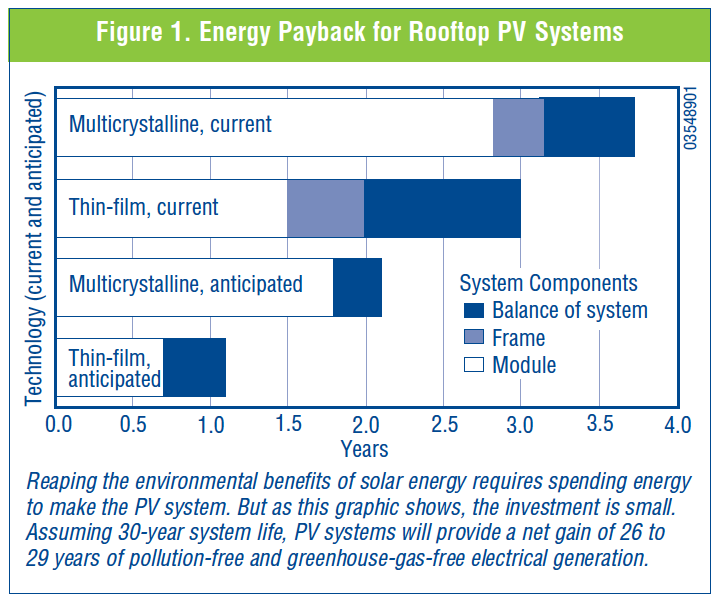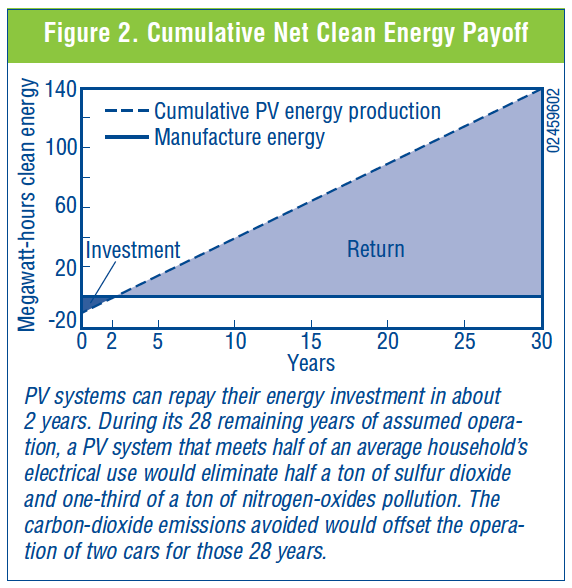While generating solar energy has countless environmental benefits and does not cause pollution or emit greenhouse gasses, the energy required to produce those solar PV systems does not always originate from renewable sources and is currently coming from fossil fuel sources primarily. As a result, solar sceptics have questioned if solar PV technology is in fact environmentally friendly and if its benefits can outweigh the energy cost of production. It’s safe to say that based on many research models and real data, the idea that solar PV cannot pay back its energy investment is simply a myth. So how long does a solar PV system have to operate to recover the energy (as well as the associated generation of pollution and CO2) that went into producing the system in the first place? In short, what is the energy payback of a solar PV system?
Here’s a graph by The National Renewable Energy Laboratory, a US Department of Energy national laboratory, which outlines the energy payback for rooftop PV systems depending on the solar PV technology. This graph does not take into account additional support structures for ground-mounted systems.
Please note that since this graph is fairly outdated as it was created for a report in 2004, the anticipated energy payback estimate is now the current estimate.
Energy payback estimates for rooftop PV systems:
- 2 years for multicrystalline modules
- 1 year for thin-film modules
However, additional racking and support structures for ground-mounted systems, which might be more advantageous for utility generation, would add about another year to the payback period. With energy paybacks of 1 to 2 years and assumed life expectancies of 30 years, 93 – 97% of the energy that PV systems generate is pollution and emission free.
Another factor that needs to be taken into account when determining the energy payback of a solar PV system is geographical location. For instance, PV systems in Northern Europe have 2.5-year energy payback, while PV systems in the South have an energy payback of less than 1.5 years, depending on the technology installed. (Source: PV Report by Fraunhofer Institute for Solar Energy Systems, November 2016)
In addition to that, the amount of CO2 emitted during panel manufacturing will depend on where it was made, and the amount of emitted gas it has saved will depend on where it is installed. A panel made in China, for example, costs nearly double the greenhouse gas emissions of one made in Europe since China relies more on fossil fuels for generating power. However, the environmental benefits of solar is greater in China than in Europe, as the clean power produced by solar PV systems would replace electricity that would otherwise be generated largely by burning coal or gas.
A recent study by Wilfried van Sark, of Utrecht University in the Netherlands, and his colleagues, calculated the energy required to make all of the solar panels installed around the world between 1975 and 2015, and the carbon-dioxide emissions associated with producing that energy. They found that solar panels made today are responsible for approximately 20 grams of CO2 per kWh of energy they produce over their lifetime (estimated as 30 years, regardless of when a panel was manufactured). To provide some perspective, in 1975, it was 400-500 grams of CO2 per kWh. Energy payback for solar PV systems has fallen from 20 years to 2 years or less, as manufacturing processes have become more efficient. For every doubling of the world’s solar capacity, the energy required to make a panel fell by around 12% and associated carbon-dioxide emissions by 17-24%.
So perhaps what we should be focusing on is how much CO2 and pollution is avoided by installing a solar PV system… An average household in Alberta consumes 600 kWh of electricity per month. On average, producing 1000 kWh of electricity with solar power reduces emissions by nearly 8 pounds of sulfur dioxide, 5 pounds of nitrogen oxides, and more than 1,400 pounds of carbon dioxide. Here’s what the cumulative net clean energy payoff looks like for a solar PV system with a 2-year energy payback which is sized to meet at least half of a household’s electricity usage.
Impressive right? Solar PV is clearly the way forward and a smart energy investment with environmental benefits, which outweigh the cost of production. Plus, with the rise in renewable energy production worldwide, it won’t be long till solar modules are produced by 100% renewable sources!



